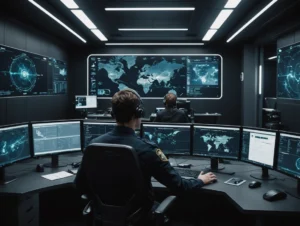In the rapidly evolving landscape of cybersecurity, the integration of artificial intelligence (AI) is becoming indispensable. As organizations face increasingly sophisticated cyber threats, AI-driven solutions are emerging as powerful tools for enhancing security defenses. One such innovative solution is Crewai, an AI-powered platform designed to revolutionize cybersecurity by providing advanced threat detection, proactive security measures, and robust data protection. This article explores the pivotal role that Crewai plays in shaping the future of cyber defense.
The Evolution of Cybersecurity in the AI Era
The cybersecurity landscape has undergone a significant transformation with the advent of artificial intelligence. Traditional security measures, while still relevant, often struggle to keep pace with the rapid evolution of cyber threats. AI offers a paradigm shift by enabling more intelligent and adaptive security systems. These systems can learn from vast amounts of data, identify patterns, and predict potential threats long before they materialize.
With the integration of AI, cybersecurity has become more dynamic and responsive. Machine learning algorithms can analyze network traffic in real-time, detecting anomalies that might indicate a security breach. For instance, a simple script to monitor network activity might look like this:
import socket
from scapy.all import *
def packet_callback(packet):
if packet.haslayer(IP):
ip_src = packet[IP].src
ip_dst = packet[IP].dst
print(f"IP Source: {ip_src}, IP Destination: {ip_dst}")
sniff(filter="ip", prn=packet_callback, store=0)This script captures and analyzes IP packets, providing a foundation for more advanced anomaly detection.
Moreover, AI-powered solutions can adapt to new types of threats by continuously learning and updating their models. This adaptability is crucial in an era where cyber attackers are constantly developing new tactics. By leveraging AI, organizations can build more resilient and future-proof cybersecurity systems.
As AI continues to evolve, its role in cybersecurity will become even more pronounced. The ability to process and analyze vast amounts of data in real-time will enable organizations to stay ahead of emerging threats. This evolution marks a shift from reactive to proactive security measures, ensuring that organizations are better prepared to face the challenges of the digital age.
Leveraging Crewai for Enhanced Threat Detection
Crewai stands at the forefront of AI-driven cybersecurity solutions, offering enhanced threat detection capabilities that are unparalleled in the industry. By harnessing the power of advanced machine learning algorithms, Crewai can identify and mitigate threats with unprecedented accuracy and speed. This is achieved through a combination of supervised and unsupervised learning techniques, allowing the system to detect both known and unknown threats.
One of the key features of Crewai is its ability to analyze large volumes of security data in real-time. This capability is essential for identifying potential threats before they can cause significant damage. For example, Crewai can monitor log files for unusual patterns that may indicate a security breach. A simple log file analysis script might look like this:
import re
from collections import Counter
def analyze_logs(log_file):
with open(log_file, 'r') as file:
log_data = file.readlines()
ip_addresses = re.findall(r'bd{1,3}.d{1,3}.d{1,3}.d{1,3}b', ' '.join(log_data))
ip_counter = Counter(ip_addresses)
for ip, count in ip_counter.items():
if count > 100: # Arbitrary threshold for demonstration
print(f"Potential threat detected from IP: {ip}")
analyze_logs('security_logs.txt')This script counts the occurrence of IP addresses in log files, helping to identify potential threats based on abnormal activity.
Crewai also employs behavioral analysis to detect anomalies in user and system behavior. By establishing baselines for normal activity, the system can quickly identify deviations that may indicate a security threat. This approach is particularly effective in detecting insider threats and advanced persistent threats (APTs).
Furthermore, Crewai’s threat detection capabilities are enhanced by its ability to integrate with existing security infrastructure. This seamless integration allows organizations to leverage their current investments while benefiting from Crewai’s advanced capabilities. As a result, organizations can achieve a more comprehensive and effective security posture.
Integrating AI for Proactive Security Measures
Proactive security measures are essential for staying ahead of cyber threats. AI plays a crucial role in enabling organizations to anticipate and mitigate potential risks before they materialize. Crewai takes this a step further by providing a range of proactive security features that enhance an organization’s ability to defend against cyber attacks.
One of the key proactive measures offered by Crewai is predictive analytics. By analyzing historical data and identifying patterns, Crewai can predict potential security incidents with a high degree of accuracy. This allows organizations to take preemptive actions to mitigate risks. For example, a predictive analytics script might look like this:
import pandas as pd
from sklearn.ensemble import RandomForestClassifier
def predict_threats(data_file):
data = pd.read_csv(data_file)
features = data.drop('target', axis=1)
target = data['target']
model = RandomForestClassifier(n_estimators=100, random_state=42)
model.fit(features, target)
predictions = model.predict(features)
for i, prediction in enumerate(predictions):
if prediction == 1:
print(f"Potential threat detected in record {i}")
predict_threats('security_data.csv')This script uses a Random Forest classifier to predict potential threats based on historical data.
Crewai also offers automated response mechanisms that can quickly contain and mitigate threats as they are detected. These responses can include isolating affected systems, blocking malicious IP addresses, or even patching vulnerabilities in real-time. This automation ensures that threats are addressed promptly, minimizing their impact on the organization.
Moreover, Crewai provides customizable dashboards and reporting tools that give security teams real-time visibility into potential threats and ongoing incidents. These tools enable organizations to make data-driven decisions and prioritize their security efforts effectively. By providing actionable insights, Crewai empowers security teams to take proactive measures and enhance their overall security posture.
The integration of AI for proactive security measures also extends to threat intelligence sharing. Crewai can aggregate and analyze threat intelligence from various sources, providing organizations with a comprehensive view of the threat landscape. This intelligence sharing enables organizations to stay informed about emerging threats and adapt their security strategies accordingly.
Transforming Data Protection with Advanced Algorithms
Data protection is a critical component of cybersecurity, and Crewai’s advanced algorithms offer a new level of security for sensitive information. By employing cutting-edge encryption and data masking techniques, Crewai ensures that data remains secure both at rest and in transit. This comprehensive approach to data protection is essential for safeguarding against data breaches and unauthorized access.
One of the key features of Crewai’s data protection capabilities is its use of homomorphic encryption. This advanced encryption technique allows data to be processed and analyzed without being decrypted, ensuring that sensitive information remains secure throughout its lifecycle. A simple example of homomorphic encryption in Python might look like this:
from phe import paillier
public_key, private_key = paillier.generate_paillier_keypair()
def encrypt_data(data, public_key):
encrypted_data = [public_key.encrypt(x) for x in data]
return encrypted_data
def decrypt_data(encrypted_data, private_key):
decrypted_data = [private_key.decrypt(x) for x in encrypted_data]
return decrypted_data
data = [1, 2, 3, 4, 5]
encrypted_data = encrypt_data(data, public_key)
print(f"Encrypted Data: {encrypted_data}")
decrypted_data = decrypt_data(encrypted_data, private_key)
print(f"Decrypted Data: {decrypted_data}")This script demonstrates how data can be encrypted and decrypted using homomorphic encryption.
Crewai also employs machine learning models to detect and mitigate data exfiltration attempts. By analyzing network traffic and user behavior, these models can identify unusual patterns that may indicate data theft. This proactive approach to data protection ensures that organizations can quickly respond to potential breaches and minimize data loss.
Furthermore, Crewai’s data protection capabilities include advanced access control mechanisms. These mechanisms ensure that only authorized users and systems can access sensitive data, reducing the risk of unauthorized access. By implementing role-based access control (RBAC) and attribute-based access control (ABAC), Crewai provides a granular and flexible approach to data protection.
The integration of advanced algorithms for data protection also extends to data anonymization and pseudonymization techniques. These techniques ensure that sensitive information is protected while still allowing for data analysis and processing. By applying these methods, Crewai enables organizations to comply with data protection regulations and maintain the privacy of their users.
Crewai’s Role in Shaping the Future of Cyber Defense
As cyber threats continue to evolve, the role of AI in cyber defense becomes increasingly vital. Crewai is at the forefront of this transformation, providing organizations with the tools and capabilities needed to stay ahead of emerging threats. By leveraging advanced AI technologies, Crewai is shaping the future of cyber defense and setting new standards for security excellence.
One of the key ways Crewai is shaping the future of cyber defense is through its continuous learning and adaptation capabilities. By constantly updating its models and algorithms, Crewai ensures that organizations are protected against the latest threats. This adaptability is crucial in a landscape where cyber attackers are continuously developing new tactics and techniques.
Crewai also plays a pivotal role in enhancing collaboration and information sharing within the cybersecurity community. By providing a platform for threat intelligence sharing and collaborative analysis, Crewai enables organizations to benefit from the collective knowledge and expertise of the community. This collaborative approach strengthens the overall cyber defense ecosystem and helps organizations stay informed about emerging threats.
Furthermore, Crewai is committed to promoting cybersecurity awareness and education. By offering training programs and resources, Crewai empowers organizations and individuals to enhance their cybersecurity skills and knowledge. This focus on education and awareness is essential for building a robust and resilient cyber defense infrastructure.
Looking ahead, Crewai will continue to innovate and develop new AI-driven solutions to address the evolving challenges of cybersecurity. By staying at the cutting edge of technology and maintaining a commitment to excellence, Crewai is poised to play a crucial role in shaping the future of cyber defense. As organizations navigate the complex and ever-changing landscape of cyber threats, Crewai will be a trusted partner in their journey towards enhanced security and resilience.
In conclusion, Crewai represents a significant advancement in the field of cybersecurity, offering a comprehensive and AI-driven approach to threat detection, proactive security measures, and data protection. By harnessing the power of advanced algorithms and machine learning, Crewai enables organizations to stay ahead of emerging threats and build resilient security infrastructures. As cyber threats continue to evolve, the role of AI in cyber defense will become increasingly important, and Crewai is well-positioned to lead this transformation and shape the future of cyber defense.




